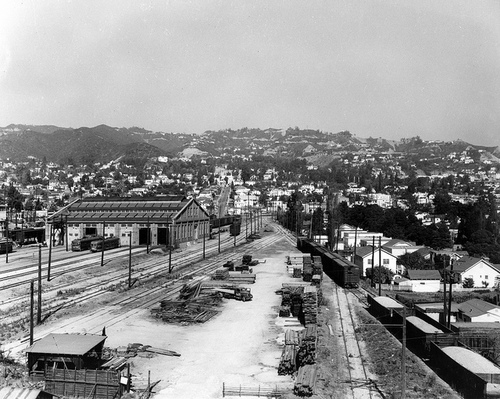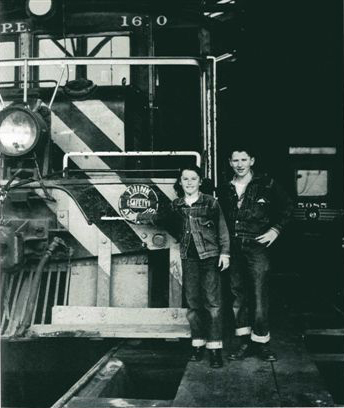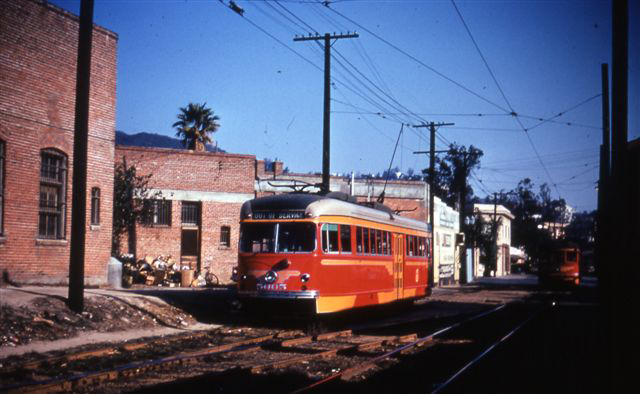Pacific Electric “Box Motor” PCC 5005: Desperate Times Call For Desperate Measures
By Ralph Cantos
On April 14, 1912, just after the RMS Titanic struck an iceberg, Captain Smith was informed by the Titanic’s builder Thomas Andrews that the Titanic was doomed and was going to sink.
In October of 1953, when Jessie L. Hough purchased the passenger operations of the once-great Pacific Electric, he informed everyone involved with the PE’s rail operations that all remaining rail lines (2 in the Western District, 5 in the Southern District) were “DOOMED.”
And like the Titanic’s brave chief engineer, whose men worked selflessly down below decks to keep the steam up, so electric lights and water pumps worked as long as possible, keeping Titanic afloat long enough to give some passengers more time — the PE crews of the Western District continued to provide top-notch service, despite their looming terminations.
And so it was during the last weeks of August 1954 that the dedicated and hard-working “Toluca Yard Shop Force” would do everything possible to keep the Glendale-Burbank Line alive and fully operational, knowing full well that the line was doomed.
The September 26, 1954, abandonment of the Hollywood Boulevard Line meant that West Hollywood Shops would be unreachable by electrified rail cars of the Glendale-Burbank Line. All maintenance for the remaining 30 PCC and 15 Hollywood cars would be performed under primitive conditions in Toluca Yard.
This photo by the late, great Ira L. Swett was taken at Gardner Junction just a few weeks before the Hollywood Boulevard Line abandonment. It was now time for any and ALL usable parts at West Hollywood to be gathered up and moved to Toluca Yard.
And like the Titanic, the Glendale-Burbank line, PE’s most modern and technically advanced rail line, was doomed. Toluca Yard’s shop men would keep the cars and infrastructure in good working order until the very end, just 9 months later.
In this photo, the 5005 is deadheading to West Hollywood Shops to load up everything usable, and then return to Toluca Yard. According to Ira, several of these “box-motor” trips were made with various PCCs loaded with valuable parts to prolong the inevitable.
The Glendale-Burbank line went down with trolley poles held high. All 45 cars, track, overhead and signals were in perfect working order to the very end.
Ralph Cantos Collection

PE’s vast West Hollywood Shops in about 1946. A Hollywood car and PCC can be seen in front of doors #2 and #3. The shops did “running repairs” for Western District cars for decades. With the September 1954 abandonment of the Hollywood Bouleard Line , the shops were no longer accessible by Glendale -Burbank Line cars. By the end of 1954, the Glendale-Burbank Line was an “electrified island” in a sea of asphalt, under siege by a pro bus / anti-rail MCL management. Ralph Cantos Collection.

Rail fan and book publisher Jeff Moreau and his sister Stefanie pose for the camera in 1951 at West Hollywood Shop along with juice jack 1620 and Hollywood car 5085. Stefanie would go on to fame as actress Stefanie Powers. This photo is from the book “Growing Up With Trains” from long gone Interurban Press. Photo from the Jeff Moreau collection.





Back around 1967, I saw what was probably the last “passenger” action at the West Hollywood yard. Wealthy publisher Hasting Harcourt had decided to sell his private railroad car and had it moved to this location for sale. The auction was conducted by Milton Wershow, the dean of Southern California industrial auctioneers. Watching Mr. Wershow was seeing a master at work. He got the bidding up to $60,000, and the winning bidder was Ray Kroc, the CEO of McDonald’s. Upon learning who the new owner was, one attendee at the sale conjured up a vision of a white-coated car steward entering the dining room with a silver tray, bearing a bagfull of Big Macs. For years the car was stored on a spur in City of Industry, next to the bakery that cranked out the burger buns.
Very informative. I find it baffling that most people believe or prefer
the BS that the powers that be dish out: A TROLLEY SYSTEM WILL NOT WORK IN LA.
The LA Metro line I ride most often is the Gold Line. Even at off-peak hours, I’ve been on trains with standing loads. The Blue Line runs three-car trains all day long. Last month we had the dedication and open house at the new Monrovia Operations Campus, with shops that are light-years ahead of the makeshift facilities that the Red Car system had in its final years. One person who observed that the Gold Line Foothill Extension to Azusa is almost finished, said, “Why can’t they open it sooner? I’m tired of fighting the 210 Freeway every day!”
Note the old shop building still standing
at right.
Another PE site to be found committed to film from the Highway Patrol television series. I believe it might be one of the final episodes of 1959 filmed at and around the shop building. Buses can be seen in the distant background.